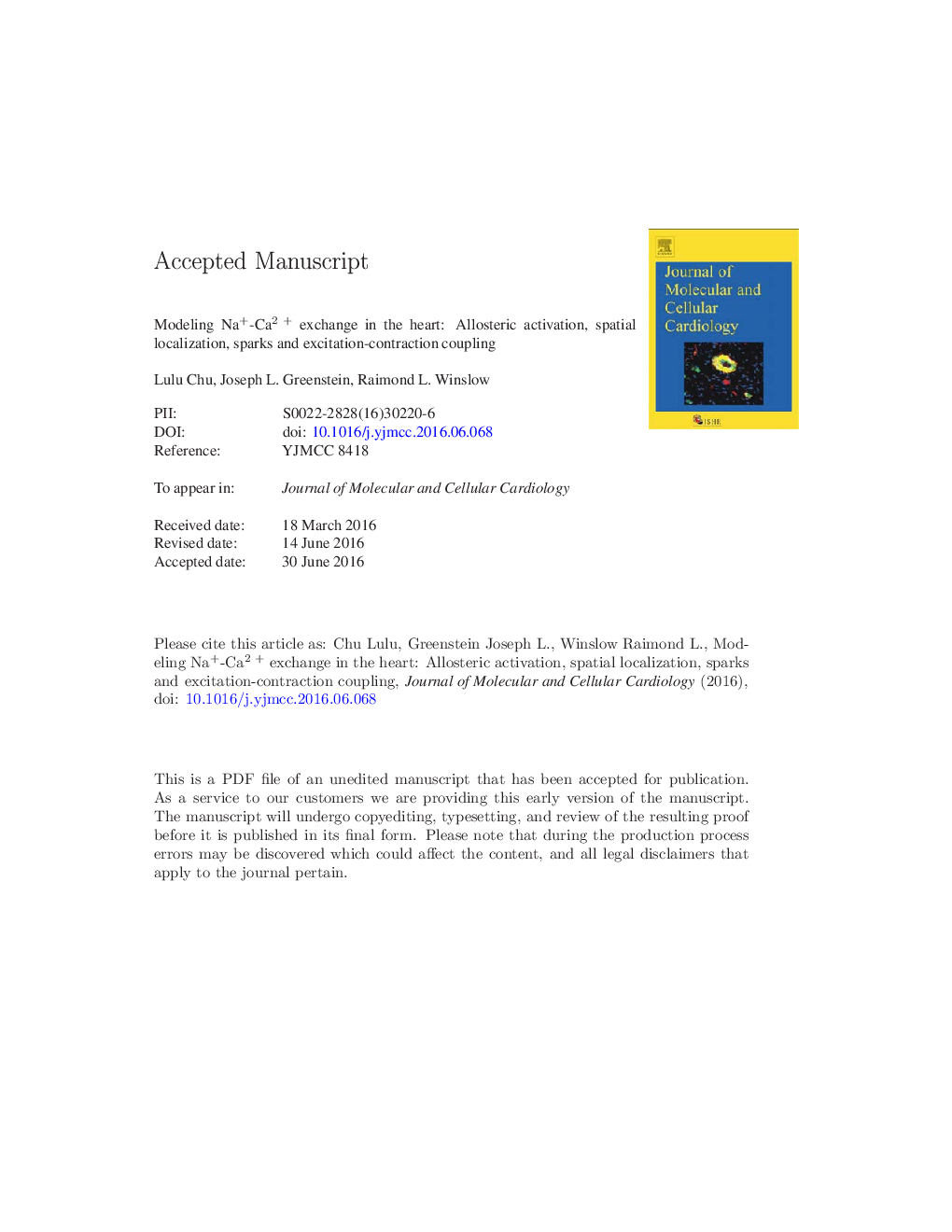| کد مقاله | کد نشریه | سال انتشار | مقاله انگلیسی | نسخه تمام متن |
|---|---|---|---|---|
| 8473689 | 1550407 | 2016 | 36 صفحه PDF | دانلود رایگان |
عنوان انگلیسی مقاله ISI
Modeling Na+-Ca2Â + exchange in the heart: Allosteric activation, spatial localization, sparks and excitation-contraction coupling
دانلود مقاله + سفارش ترجمه
دانلود مقاله ISI انگلیسی
رایگان برای ایرانیان
کلمات کلیدی
موضوعات مرتبط
علوم زیستی و بیوفناوری
بیوشیمی، ژنتیک و زیست شناسی مولکولی
بیولوژی سلول
پیش نمایش صفحه اول مقاله

چکیده انگلیسی
The cardiac sodium (Na+)/calcium (Ca2Â +) exchanger (NCX1) is an electrogenic membrane transporter that regulates Ca2Â + homeostasis in cardiomyocytes, serving mainly to extrude Ca2Â + during diastole. The direction of Ca2Â + transport reverses at membrane potentials near that of the action potential plateau, generating an influx of Ca2Â + into the cell. Therefore, there has been great interest in the possible roles of NCX1 in cardiac Ca2Â +-induced Ca2Â + release (CICR). Interest has been reinvigorated by a recent super-resolution optical imaging study suggesting that ~Â 18% of NCX1 co-localize with ryanodine receptor (RyR2) clusters, and ~Â 30% of additional NCX1 are localized to within ~Â 120Â nm of the nearest RyR2. NCX1 may therefore occupy a privileged position in which to modulate CICR. To examine this question, we have developed a mechanistic biophysically-detailed model of NCX1 that describes both NCX1 transport kinetics and Ca2Â +-dependent allosteric regulation. This NCX1 model was incorporated into a previously developed super-resolution model of the Ca2Â + spark as well as a computational model of the cardiac ventricular myocyte that includes a detailed description of CICR with stochastic gating of L-type Ca2Â + channels and RyR2s, and that accounts for local Ca2Â + gradients near the dyad via inclusion of a peri-dyadic (PD) compartment. Both models predict that increasing the fraction of NCX1 in the dyad and PD decreases spark frequency, fidelity, and diastolic Ca2Â + levels. Spark amplitude and duration are less sensitive to NCX1 spatial redistribution. On the other hand, NCX1 plays an important role in promoting Ca2Â + entry into the dyad, and hence contributing to the trigger for RyR2 release at depolarized membrane potentials and in the presence of elevated local Na+ concentration. Whole-cell simulation of NCX1 tail currents are consistent with the finding that a relatively high fraction of NCX1 (~Â 45%) resides in the dyadic and PD spaces, with a dyad-to-PD ratio of roughly 1:2. Allosteric Ca2Â + activation of NCX1 helps to “functionally localize” exchanger activity to the dyad and PD by reducing exchanger activity in the cytosol thereby protecting the cell from excessive loss of Ca2Â + during diastole.
ناشر
Database: Elsevier - ScienceDirect (ساینس دایرکت)
Journal: Journal of Molecular and Cellular Cardiology - Volume 99, October 2016, Pages 174-187
Journal: Journal of Molecular and Cellular Cardiology - Volume 99, October 2016, Pages 174-187
نویسندگان
Lulu Chu, Joseph L. Greenstein, Raimond L. Winslow,